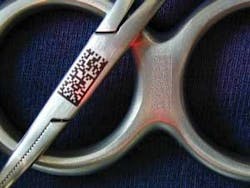Verifying laser marks
Machine-readable identification holds the key to manufacturing efficiency
Machine-readable identification is fast becoming a trend throughout many industry sectors and is used to automatically identify a variety of products. Manufacturers are marking parts with machine-readable, permanent, two-dimensional (2D) data matrix codes that are placed directly on the part itself. Then the part can be tracked throughout its entire life cycle, including manufacturing and supply chain operations. This is called Direct Part Mark Identification (DPMI) or Auto-ID. Established industry DPMI specifications and 2D marking guidelines are listed in the table.
DPMI enables manufacturers to improve manufacturing process performance, identify quality defects through in-service tracking, eliminate manual part data-entry errors, support data logging and automated data collection, increase yields, and reduce the direct and indirect costs of manufacturing.
Many manufacturers rely on Auto-ID as well to track high-value parts to prevent theft or counterfeiting, identify parts for maintenance and returns, and to resolve warranty issues and liability claims.
Two-dimensional data matrix symbols are the most common symbologies used for DPMI due to their small size, data capacity, and error correction, plus their ability to be produced by a variety of marking methods. Common methods to apply 2D codes are laser, dot peen, and electro-chemical etch. The 2D data matrix code consists of an arrangement of small dots or squares, marked as either a square or rectangle (see Figures 1 and 2).
To ensure consistent, high-quality 2D data matrix symbols marked directly on parts, many automotive and aerospace companies immediately verify the code following the marking operation. Verification is a method that objectively determines the quality of the mark based upon a comparison of a direct part mark to an established specification or standard. The goal of verification is to ensure that the code is marked to the highest possible degree of quality.
If manufacturers are to realize the benefits of DPMI, it is essential that the marking equipment apply a mark that will deliver the highest read rates within a part’s lifecycle. Verification enables part suppliers to meet the demands of supply contracts (such as found in DOD) requiring direct part marking on parts and assemblies. If the 2D code is not readable at every desired step downstream throughout the manufacturing or supply chain operations, manufacturing errors, scrap, or downtime caused by unreadable codes may result.
Verification is also used to monitor the performance of the direct part marking method. A verification system will immediately report a problem with the marking equipment, which could be caused by the following: poor fixturing of the part, malfunction of the marking machine, surface changes in the material being marked, or incorrect machine settings after part changeover.
A 2D data matrix verifier is a system that includes a fixed station camera, optics, lighting, part fixtures, and data matrix verification software tools. Because marking requirements are as individual as the end products themselves due to the wide range of materials and surface conditions that are marked, a DPMI verification system should be defined for each application. The desired result is a controlled and repeatable set-up of camera/verifier, optics, and lighting that takes the following into account: the set-up of the lighting, the specified standoff distance of the symbol from the camera, the specified lens/aperture/focus settings of the camera, and the part fixtures
Typically, a smart camera with verification software reads the symbol and compares it to the appropriate specification. A report is produced on every specification parameter and an overall grade based on the results is given. Verification considers surface color and finish and marking techniques.
The camera can be mounted either on the marking equipment (in-line) or nearby the marking equipment as a separate off-line system. The mark’s conformance to the specification is then communicated to the operator as either pass or fail.
When the code quality begins to deteriorate, the verification system can signal an operator that the marking process is drifting out of control. Corrective adjustments can be made or preventive maintenance can be performed immediately, before production is impacted and scrap parts are produced.
The optimum configuration for a direct part mark verifier is typically different than that for a reader. Direct part mark verification requires higher camera resolution than for reading (more pixels per data matrix cell). For this reason, fixed-station cameras/verifiers, generally with internal lighting, are used. Meaningful verification results can only be generated by consistent and repeatable part presentation of the mark to the verifier, with the axis of the camera generally perpendicular to the mark surface. Also critical to proper verification is a consistent, uniform lighting environment on the part. For low contrast marks, supplemental lighting is often the key to successful verification results.
Readable marks generally result when the symbol itself is sufficiently differentiated from the part surface, in color/contrast and texture/roughness. However, verification does not guarantee that a reader will read the mark. Metal removal operations, heat treatment, painting, and part coatings such as rust inhibitors may degrade the mark such that it is unreadable downstream of the marking operation.
Verification uses a set of quality measures developed specifically for DPMI. For 2D symbols produced by laser marking, dot peen marking, and electro-chemical etching, International Aerospace Quality Group (IAQG) 9132 (January 2005 edition) is an emerging industry standard that specifies technical and quality requirements for data matrix marks.
For laser-produced marks, IAQG quality metrics measure the following parameters to determine if a 2D mark is acceptable and assigns a grade based upon the following factors: Cell shape, contrast level between the marking and its substrate (gray density difference of 20% or greater), or cell fill of 60-105% of the nominal cell size.
The grades are A (excellent), B (acceptable), or F (failure) for each parameter. The overall grade is assigned based upon the lowest parameter grading.
Verification takes the guesswork out of maintaining consistently high mark quality. It also maintains conformance to the appropriate standard, which should improve reading/decoding capability later in production, as the mark may deteriorate. Full verification can be implemented at each marking station to guarantee good initial mark quality, thus assuring readability or decoding of the mark at any follow-on production steps, either at your own site or at your customer’s facilities.
Verification is an excellent real-time method to keep the marking operation in control and to standard, thus helping manufacturers improve their processes through direct part marking.
Chris Davis ([email protected]) is vice president of DAPRA Marking Systems, Bloomfield, CT (www.dapramarking.com).



